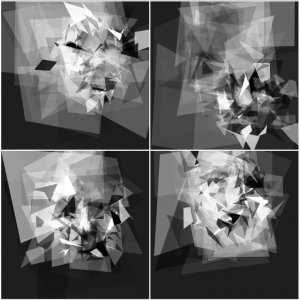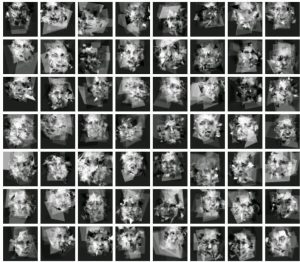
http://iobound.com/pareidoloop/
Phil McCarthy created the project Pareidoloop, which combines a facial recognition algorithm with a random polygon generator algorithm to produce a somewhat recognizable face. The programs works by generating random sized, coloured and shaped polygons that are then layered on top of each other until the facial recognition algorithm recognizes a face. All other variables, except the random polygon generator, can be set by the user, such as size of image, fitness or how likely the “face” matches an actual face and number of generations. The maximum fitness level is 35, where the lower the number, the faster the image renders but the rendered face may not be recognizable. Number of generations is how many times the code runs until it stops to find another face. McCarthy was inspired by the idea of pareidolia, which is a when the mind responds to an image by perceiving a pattern within random data. An example of that would be objects in cloud formations or Pixar’s The Blue Umbrella short film.

There are certain user controlled variables, yet each time the code runs, the generated image is very different. There are so many different possibilities to this code. What I like about this project is how a face is a very defined image, but even when abstracted into simple polygons, from a distance, each face looks different from each other.
![[OLD FALL 2017] 15-104 • Introduction to Computing for Creative Practice](https://courses.ideate.cmu.edu/15-104/f2017/wp-content/uploads/2020/08/stop-banner.png)